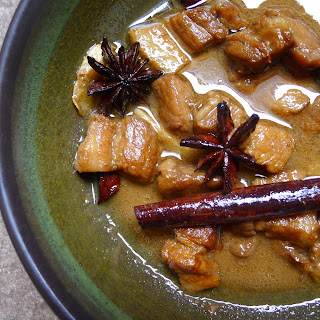 This little gem lay on a dusty shelf in a resale store in DeKalb, IL, swathed in a dust cover so busy and unstylish that nearly caused me to pass it by.
This little gem lay on a dusty shelf in a resale store in DeKalb, IL, swathed in a dust cover so busy and unstylish that nearly caused me to pass it by.I've never been one for encyclopedic food books, and the Larousse Gastronomique always seemed extra fuddy-duddy. But my curiosity was piqued by the mention of 'First English Edition.' Trying to ignore the terribly-composed, grainy black and white pictures, I skimmed on and on. The photos bore the unfortunate quality of depicting those very food items that resist black-and-white photography, such as cauliflower au gratin and eggs a la florentine. I am sure bad photography was not what Prosper Montagné imagined in 1938 when he set out to complete the orgean task of collecting French ingredients, foods, recipes and traditions.
 The Larousse has been updated many times over, resulting in, I'm sure, many deep excavations into the very definition of French cuisine. Does it stop at the holy temples of Escoffier or Careme? Or are we allowed to freely admit that the French, like everyone else, eagerly filched from their colonial encounters? Today's Larousse reflects this political correctness, or so I hear. This 1961 English edition, on the other hand, tries to preserve the original French edition for an educated Anglo-American audience. The edition gives both metric and imperial measures, blessing for my own trans-Atlantic confusion of a life. Wonderful charts show meat cuts in three culinary traditions -
American, French and English. And the maps! Place names disappear from the French regions, replaced by iconic foods of la terroir. The maps are a work of art.
The Larousse has been updated many times over, resulting in, I'm sure, many deep excavations into the very definition of French cuisine. Does it stop at the holy temples of Escoffier or Careme? Or are we allowed to freely admit that the French, like everyone else, eagerly filched from their colonial encounters? Today's Larousse reflects this political correctness, or so I hear. This 1961 English edition, on the other hand, tries to preserve the original French edition for an educated Anglo-American audience. The edition gives both metric and imperial measures, blessing for my own trans-Atlantic confusion of a life. Wonderful charts show meat cuts in three culinary traditions -
American, French and English. And the maps! Place names disappear from the French regions, replaced by iconic foods of la terroir. The maps are a work of art.The 1961 Larousse is not so much an encyclopedia as a bookmark, capturing an important, enthusiastic moment in the Franco-American culinary relations, a moment that also allowed for Julia Child's Mastering the Art of French Cooking, published that same year, to shine.








